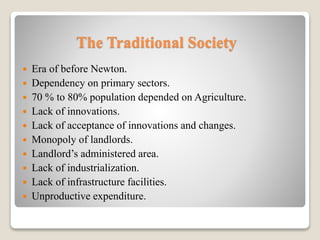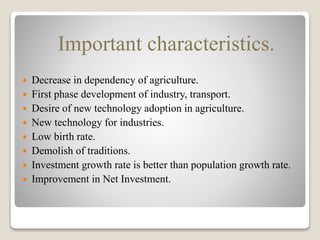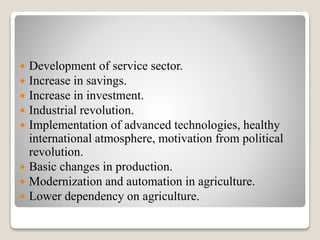Rostow theory of economic growth
- 1. Rostow’s Theory of Economic Growth Prof.Gadhave.V.V Arts & commerce college Madha B.Com III & B.A III
- 3. About Rostow Walt Whitman Rostow. American economist & political theorist. The son of Russian immigrants. Born on 7 October 1916 at New York. Entered Yale University at age 15 on a full scholarship for B.A. Received a Ph.D. in economics from Yale University in 1940. Taught Economics at Columbia University. World War II Rostow joined the Office of Strategic Services. For his additional work with the British Air Ministry in 1945 he was awarded the Legion of Merit.
- 4. His first book “The American Diplomatic Revolution” published on November 1946. “Essays on the British Economy of the Nineteenth Century” published 1948. Published book “The Stages of Economic Growth : A non communist manifesto” in 1960. Director of policy planning.(U.S.A) Worked as “special assistant for national security affairs”.(U.S.A) Associated with the Israeli nuclear program. Died on 13 February 2003 at Austin.
- 5. Rostow’s Theory of Economic Growth Stages involved in the theory. The Traditional society. Pre condition for Take-off. The Take-off stage. The Drive to Maturity. The Age of High Mass Consumption.
- 6. The Traditional Society Era of before Newton. Dependency on primary sectors. 70 % to 80% population depended on Agriculture. Lack of innovations. Lack of acceptance of innovations and changes. Monopoly of landlords. Landlord’s administered area. Lack of industrialization. Lack of infrastructure facilities. Unproductive expenditure.
- 7. Religious beliefs. Expenses on religious traditions and activities. Economy is static in nature. Lack new processes adoption in industrialization, business and agriculture. No changes in agriculture, industry and business. Quality of the person depended on their caste. Backward in development. Society is involved in breed, caste, family. Period of this stage is uncertain.
- 8. Pre-condition for Take-off Preparation of Self-sufficient development. Started 15th and 16th century in Europe. Thinking towards economic development. Nationalism. Realizing about profits. Improvement in Savings and Investment. New entrepreneurs. Development of new financial institutions and banks. Belief of economic development.
- 9. Three important changes 1. Creation of up gradation capital should be generated from the surplus of agriculture production. 2. Technological revolution in agriculture to fulfill the need of urban and rural people. 3. With the increase in the productivity of agriculture there should be demand of different types of machines, fertilizers, chemicals. Export of natural resources, raw material exchange of capital goods and machinery.
- 10. Important characteristics. Decrease in dependency of agriculture. First phase development of industry, transport. Desire of new technology adoption in agriculture. New technology for industries. Low birth rate. Demolish of traditions. Investment growth rate is better than population growth rate. Improvement in Net Investment.
- 11. The take-off stage Important stage of economic growth. Development of sectors. Strong self belief of development. Higher growth rate of development. Changes in the society. Generally 20 to 30 years time period. Increase in number of employees due to industrialization.
- 12. Development of service sector. Increase in savings. Increase in investment. Industrial revolution. Implementation of advanced technologies, healthy international atmosphere, motivation from political revolution. Basic changes in production. Modernization and automation in agriculture. Lower dependency on agriculture.
- 13. Three conditions for take-off stage. 1. Higher net investment rate. Productive investment should be 10.5% to 12.5% of National Income. 2. Development of leading sectors. Primary sectors. Secondary sectors. Service sectors. 3. Structural changes in cultural society. Positive changes in generation of capital on the basis of Culture.
- 14. Some counties and their take-off period Country The take-off period Time period 1 ENGLAND 1783-1802 19 2 FRANCE 1830-1860 30 3 BELGIUM 1833-1860 27 4 UNITED STATES 1843-1860 17 5 GERMANY 1850-1873 23 6 SWEDEN 1868-1890 22 7 JAPAN 1878-1900 22 8 RUSSIA 1890-1914 24 9 CANADA 1896-1914 18 10 ARGENTINA 1935-…… .. 11 TURKASTAN 1937-…… .. 12 INDIA 1952-…… .. 13 CHINA 1952-..….. ..
- 15. The Drive to Maturity Self sustained development. Self inspired development. Matured stage. Appropriate output of new technological advancements. Maximum benefit from the available advancements and machines. Generally investment rate is 10%. Generally 60 years of time period after the take-off stage. Skilled manpower in the country. Improvement in skills and advancements of industrialists. Limited attraction of facilities.
- 16. Self inspired countries development period S.No Countries Matured stage 1 ENGLAND 1850 2 UNITED STATES 1900 3 GERMANY 1910 4 FRANCE 1910 5 SWEDEN 1930 6 JAPAN 1940 7 RUSSIA 1950 8 CANADA 1950
- 17. The age of High Mass of Consumption Higher consumption level. Higher number of products and services in an economy. Expansion of service sector. Social welfare and security. Sufficient consumption era. Possibility and ability to use and consume luxurious products. Urbanization in an economy.
- 18. Important factors in this stage Rapid growth and expansion of service sector. Increase in the workers and employees. Increase in the urbanization. Focus of production on the capital goods manufacturing lesser than the durable goods. New inventions in the new product developments. Production technology development target become secondary. Importance to the social welfare and security. Equal distribution of national income.
- 19. Progressive taxation policy. Sufficient rest to the workers. Improvement in the per capita income. Full employment, economic security, welfare. Improvement in production and consumption of the durable goods. Changes in the national policy to expand national boundaries.
- 20. Criticism Classification of economy is impossible. Not applicable to every country.( U.S.A, Canada, Australia.) Slightly differences in pre take-off and take-off stage. No actual rate of investment. Uncertain time period. Confusion in leading sectors concept. Absence of equal capital concept. No consideration of poverty and unemployment. Only figures are considered.
- 21. All economies cannot considered in only one concept. Objection on the time period. No consideration of poverty reduction schemes. No presence of The High Mass Consumption level. Changes in the future and past of every country. Development progress cannot fit in structure. The drive to maturity stage is improper. Differences in growth of population, dependency in agriculture and perception of the society in every country.
- 22. Thank you





















